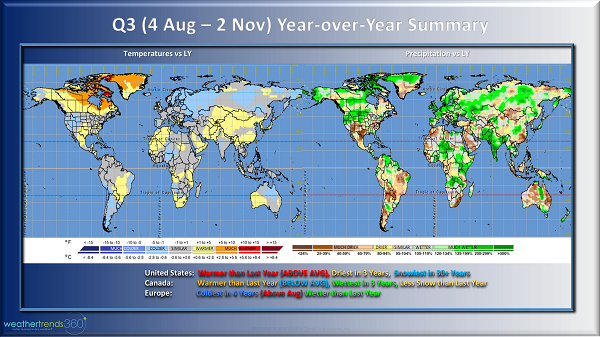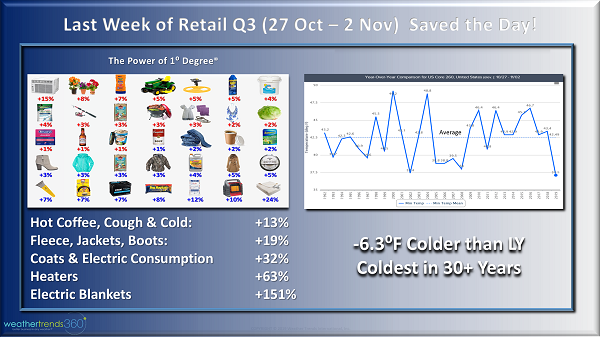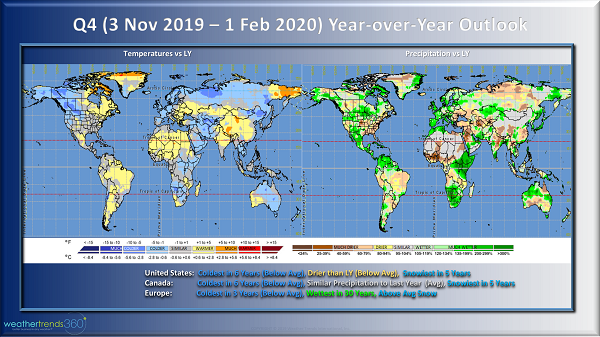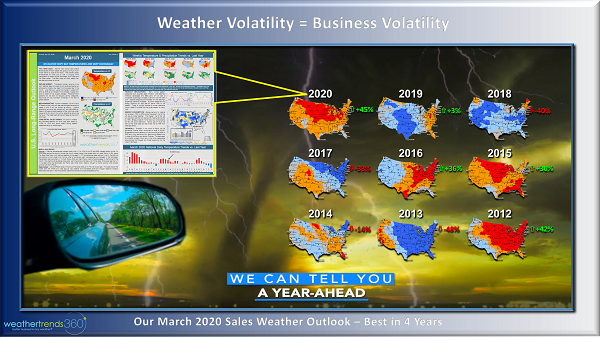2019 Q4 Seasonal Sales Forecast
The volatile weather in the final quarters of the year can bring challenges for businesses. From the delayed fall season in Q3 to the tough cold spell in early Q4, weather has made it difficult to predict your sales while closing out the year. We've developed a long-range statistics-based forecasting model to help businesses do better business in any weather. Here's a recap of Q3 sales trends and our Q4 sales and weather forecasts to help you close the year out strong.
Q3 Recap
The Q3 retail period (4 Aug - 2 Nov) was a bit warmer than last year. Despite the very cold and snowy end to the quarter, the U.S. ended up above average for Q3. In contrast to the cold and snowy close, the front half of Q3, from August to September, was the warmest in 3 years, 2nd warmest in 30+ years and driest in 4 years.
In the retail sector, this was a negative for Back to School sales and early fall apparel categories. Because the warm, summer weather held into the early fall, consumer buying intent was still focused on the products associated with the previous season. This negatively impacted sales for retail businesses that couldn't anticipate the delayed seasonal shift.
However, while the above average weather hurt retailers in some categories, it was a boon in others. The lingering summer weather was a plus for outdoor categories like lawn and garden and DIY auto categories like car wash/wax.
Overall, cold seasonal categories certainly needed early markdowns to keep inventory moving, which ate into some profits for the quarter. Consumers certainly enjoyed the extended outdoor season before the cold swell. October ended up being the coldest and snowiest in 10 years for the nation with a record shattering cold blast the last week of the quarter. The mid-quarter cold blast drove exceptional demand for seasonal sales categories, as the cold weather finally triggered seasonal consumer buying intent.
Globally, trends looked different from the U.S. Canada ended up being warmer than last year, but-unlike the U.S.-temperatures were still below average, with the wettest conditions in 3 years but less snow than last year.

Europe was the coldest in 4 years, but still above average temperature and wetter than last year. In contrast, China was both warmer and drier.
In the U.S., the overall theme for Q3 earnings season is a soft start but a very strong finish that saved the day, yielding a neutral to slightly positive weather influence on overall sales in the U.S.
The Great Last Week of Q3 Retail
The last week of the retail Q3 for the U.S. was epic, with 124 records broken for hundreds of cities. Overall, the U.S. was 6.3°F colder than last year, making that week the coldest it's been in over 30 years. By applying our Power of 1 ° Degree® technology on 10,000+ seasonal sales categories, we've estimated the sales gains and losses this cold weather caused.

Retailers likely had +13% year-over-year (YOY) sales gains for hot coffee, cough and cold medicines and hot cereal. Fleece, jackets and boots were likely up 19%, while heavier weather coats up 32%.
The extreme cold drove residential and commercial heating bills, with a likely 32% increase in consumption. Volatile hard goods like heaters were big at 63%. Electric blankets, one of the most weather-volatile categories, was up 151%. While our calculations do vary by region and store location, all signs point to a late surge that likely saved retail Q3 from being a disappointment.
Q4 Weather and Business Projections
Q4 shows the U.S. trending the coldest in 6 years. The U.S. will experience below average temperatures nationally. On the precipitation side, the U.S. will be drier than last year, but the snowiest in 5 years.
Canada is likely to follow similar trends towards a cold and intense winter. In contrast, Europe will experience its coldest winter in 4 years and extremely stormy weather, trending the wettest in 30+ years with above average snowfall.

What does this mean for business in Q4?
We've quantified that every 1 degree colder YOY improves coat sales by 7%. Retailers in the U.S. and Canada can expect high demand in this category. Increasing inventory and holding off markdowns will work to optimize coat sales.
The short but intense snow season means airlines can expect fewer delays and de-icing costs during early and late winter.
For auto retailers, the 200% increase in snowfall in the South and Midwest of the U.S. will drive high ice scraper sales during the holiday season in this region.
Looking Ahead: Q1 2020 in the U.S.
Retail sales will pick up again in earnest in the latter half of December into middle January with much colder and snowier weather. Moving further into Q1, it's very possible the polar vortex will be back by middle January. While February will trend warmer nationally, extreme cold and snow will linger in the Eastern U.S. Afterwards, expect the warmest March in 4 years, resulting in a strong Q1 2020 for business.

 Conclusion
Conclusion
Planning your end of year business can be challenging if you can't anticipate the weather before it happens. For businesses of every industry, long-range forecasts through statistics-based weather intelligence can make it easier to close the year out in the black.
Warm Regards,
Captain Bill Kirk